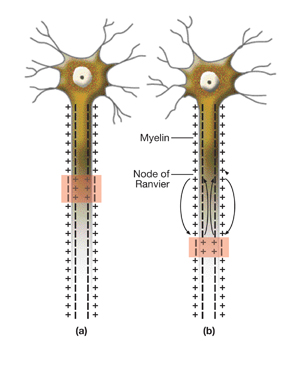Module 1
1. Module 1
1.49. Page 5
Module 1—The Nervous System
Myelin and Impulse Transmission
 Watch and Listen
Watch and Listen

© Jhaz Photography/shutterstock
In Lesson 3 you learned about the basic structures of the neuron. You discovered that some axons are wrapped in Schwann cells that produce a fatty material called myelin. Myelin acts as an insulator. In the following video clip, you will see the significance of insulation to communication in myelinated nerves versus unmyelinated nerves. Watch the following segment of “Nerve Impulse Conduction: Dentists Calms Your Nerves” before proceeding with the next section.
- "Bio Simulation: Myelinated vs. Nonmyelinated Neurons"

myelinated neuron: a neuron whose axon is wrapped by Schwann cells, which produces a myelin sheath
Myelinated neurons make up the white matter in the brain and the spinal cord and transmit nerve impulses very quickly.
unmyelinated neuron: a neuron that does not have Schwann cells and, therefore, lacks a myelin sheath
Unmyelinated neurons make up the grey matter in the brain and spinal cord and transmit nerve impulses much more slowly than myelinated neurons.
saltatory conduction: rapid transmission of a nerve impulse along an axon resulting from the action potential jumping from one node of Ranvier to another, skipping the myelinated regions of the membrane
In the video you saw that myelin is not present on all nerve cells. Myelinated neurons can conduct nerve impulses over 100 m/s, whereas unmyelinated neurons are much slower, with speeds of only 0.5 m/s. Even though the axon of the myelinated neuron is not in contact with the sodium-rich extracellular fluid outside the neuron, there is rapid communication. The nodes of Ranvier facilitate this rapid communication. In Lesson 3 you learned that the nodes of Ranvier lack myelin because they are between individual Schwann cells. Here, the axon is in contact with the extracellular fluid. The smooth wave-like nerve impulse that you studied in such detail in the previous lessons does not apply to myelinated neurons because action potentials can only occur at the nodes of Ranvier. Scientists found that the neural impulse “jumps” from one node to the next all along the axon in what is called saltatory conduction.
 Read
Read
For more detail on this process, read “Nerve Impulse” on pages 377 and 378 in the textbook. “Figure 11.16” on page 378 provides a good illustration of this process. Add this information to your course folder in a format that you prefer.

© 2008 Jupiterimages Corporation
Saltatory conduction is like a skillfully thrown rock skipping along a water surface, permitting a greatly increased speed of transmission. The speed of impulses is also increased in axons of large diameter. The fast-reacting giant axons of the squid that allow it to “jet-propel” itself away from danger are several millimeters in diameter, or 100 to 1000 times the diameter of a human axon. However, the squid’s giant axons conduct impulses at only about 30 m/s, which is far below your own capabilities.
Multiple Sclerosis
 Watch and Listen
Watch and Listen
In Lesson 1 you were introduced to multiple sclerosis (MS) and some of the ways it affects communication in the nervous system.
Watch the segment called “Bio Discovery: Multiple Sclerosis” from “Electrochemical Control Systems in Humans: Regulating Physiological Processes.”
 Self-Check
Self-Check
SC 17. MS is a disorder capable of slowing down, or even stopping, impulse transmission. Prepare a paragraph outlining the relationship between myelinated nerve function and the symptoms of MS. Indicate the specific losses of myelinated nerve function caused by MS. After you check your answer, save it in your course folder for easy access when studying.
 Self-Check Answers
Self-Check Answers
SC 17. Multiple sclerosis (MS) is a disease of the white matter tissue of the central nervous system. The white matter is made up of myelinated nerve fibres, which are responsible for transmitting communication signals both within the CNS and between the CNS and the PNS. When the myelin sheaths of nerves of the CNS are damaged, nerve impulses are significantly slowed or even stopped. People with MS can experience partial or complete loss of any function that is controlled by or passes through the brain or the spinal cord. As such, this disease results in the weakening of the skeletal muscles. Note “Figure 11.17” on page 378 of your textbook, which shows lesions in the brain where the white matter has been destroyed. All myelinated motor neurons from the CNS to the skeletal muscles of the body are affected. This results in loss of muscle coordination and function.